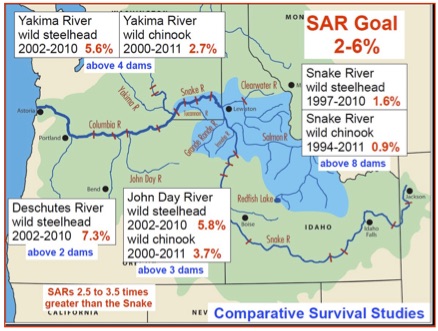forum
library
tutorial
contact

The Need to Breach the Lower Snake River Dams:
A Look at 2022 Fish Returns
by Helen Neville
Spokesman-Review, November 11, 2022
|
the film forum library tutorial contact |

|
The Need to Breach the Lower Snake River Dams:
by Helen Neville
|
Dam advocates are quick to exaggerate the slight uptick in an
attempt to convince the public the failing status quo is working.
 After a welcome improvement in ocean conditions, Snake River salmon and steelhead run numbers are a little higher this year. The fish are fighting to survive and demonstrating their remarkable resilience. But as we've seen too often, dam advocates are quick to exaggerate the slight uptick in an attempt to convince the public the failing status quo is working.
After a welcome improvement in ocean conditions, Snake River salmon and steelhead run numbers are a little higher this year. The fish are fighting to survive and demonstrating their remarkable resilience. But as we've seen too often, dam advocates are quick to exaggerate the slight uptick in an attempt to convince the public the failing status quo is working.
We can't allow 2022's run counts to lull us into a false sense of security or fall for disingenuous smoke and mirrors intentionally misrepresenting important biological and legal details. For these runs, the situation remains dire, and the science-based conclusion is that the four lower Snake River dams must be removed to ensure a future for wild salmon and steelhead.
A far cry from goals
The fact is that salmon and steelhead returns in the Snake River Basin over the past five years have been among the lowest ever recorded. This year, some salmon and steelhead returning to the Snake River have shown small improvement, but only when lumping wild and hatchery fish counts together, and only when compared to terrible recent seasons.
These are critically important distinctions, because it is wild fish that provide the profound ecological diversity and evolutionary adaption that allowed them to thrive throughout the basin for eons before the dams were built -- and that will ensure resilience for salmon and steelhead in a future without dams.
More pragmatically, it is wild fish that determine the legal obligations for recovery, mandated under the Endangered Species Act (ESA). In the Snake River, Spring/Summer Chinook, Fall Chinook, and Steelhead are ESA listed as Threatened. The basin's Sockeye Salmon are listed as Endangered, an even more severe indication of how fragile these populations are.
Today, none of these ESA listed species are anywhere near recovery goals. In some cases, wild salmon populations are hovering around 1-3% of historical run estimates. In the past five years, wild Snake River Spring/Summer Chinook numbers averaged less than half of their total return when the fish were first listed under the ESA in 1992 -- a devastating benchmark.
Make no mistake: these are populations on the brink. In 2021, Nez Perce Tribe fishery scientists reported that 42% of Snake River wild Spring/Summer Chinook populations had reached a "Quasi Extinction Threshold," a measurement indicating a population was hovering at risk of blinking out. The same report indicated that 19% of Snake River steelhead populations were also below this threshold. According to the study, both are expected to continue declining in the basin unless substantial interventions are made to recover these populations.
In the meantime, billions of dollars have been spent producing hatchery salmon and steelhead to prop up fisheries, as Congressionally mandated to mitigate the population losses caused by the dams, and it is not working to recover wild fish.
Free the Snake: The way forward
Many factors contribute to any given year's salmon and steelhead returns. Poor ocean conditions, drought, predation, and habitat degradation all combine to suppress populations. But the massive dams take a tremendous toll on anadromous species in the Snake River.
Scientific analysis has repeatedly pointed toward the negative impacts of how the dams impede juvenile and adult fish migration, heat the water to deadly temperatures, inundate 140 miles of mainstem spawning and rearing habitat, and provide ideal conditions for expanding populations of predators feasting on salmon and steelhead smolts.
This year, Washington's Governor Jay Inslee and Senator Patty Murray's report acknowledged the need to remove the four Snake River dams to recover Snake River runs. The National Oceanic and Atmospheric Administration (NOAA) released a capstone report reviewing the decades of deep science on the issue. It also came to the exact same conclusion, one that U.S. Congressman Simpson (R-Idaho) noted in his 2021 plan: reaching recovery goals for our salmon and steelhead requires a broad suite of actions, but restoration of the lower Snake River through dam breaching is the essential component.
The science-based consensus is established, and the way forward is clear. Current numbers are a sharp reminder of the pressing need to restore these populations before it is too late. These species, and the communities that depend upon them, are running out of time. The four Lower Snake River dams must be removed to save them.
learn more on topics covered in the film
see the video
read the script
learn the songs
discussion forum
